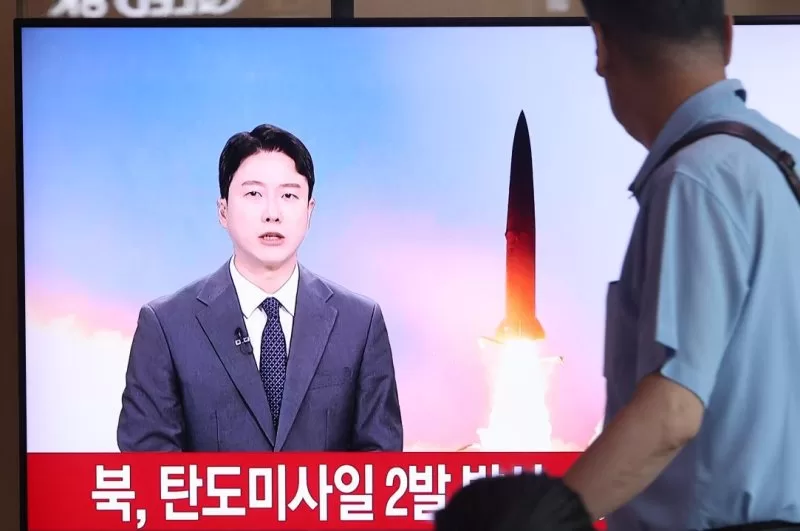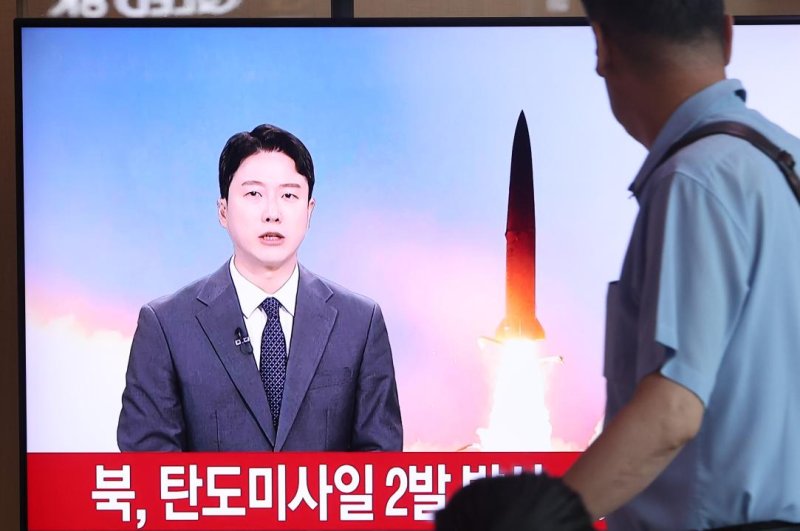North Korea fired two short-range ballistic missiles on Monday morning, but one may have failed and exploded over land, South Korea’s Joint Chiefs of Staff said. Photo by Yonhap
SEOUL, July 1 (UPI) — A North Korean missile launched Monday may have exploded in mid-air and rained debris over land, South Korean defense officials said.
Seoul’s Joint Chiefs of Staff said early Monday morning that the military detected two short-range missiles launched from the area of Jangyon in North Korea’s southwestern corner.
The first missile, launched at 5:05 a.m., flew around 370 miles and landed in waters off the northeastern city of Chongjin, the JCS said in a text message to reporters.
The second missile was launched at 5:15 a.m. but only flew some 75 miles, leading to speculation that it failed and may have exploded in mid-air.
“It is possible that the second North Korean missile flew abnormally in its early stages,” JCS spokesman Col. Lee Sung-jun said at a press briefing later in the morning.
“If it had exploded during an abnormal flight, it is possible that the debris would have fallen inland,” he said, adding that the military was still analyzing the launch.
The last short-range ballistic missile test from the Jangyon area was in March of last year, when Pyongyang fired the KN-23, a highly maneuverable weapon believed to have been used by Russia in its war against Ukraine.
Lee said Monday’s tests may also have involved the KN-23 but added that the second missile could have been a new type of weapon.
The launches come amid growing military ties and a new mutual defense treaty between North Korea and Russia, with speculation that Pyongyang is conducting tests and ramping up weapons production in anticipation of sales to Moscow and other buyers.
U.S. State Department spokesman Matt Miller said earlier this month that the North has transferred “dozens of ballistic missiles and over 11,000 containers of munitions to aid Russia’s war effort.”
Russia and North Korea have denied the allegations, but on Friday the head of a weapons research group presented evidence to the U.N. Security Council that he said “irrefutably” establishes a missile from North Korea was used on the battlefield in Ukraine.
Jonah Leff, director of Conflict Armament Research, told the Council that the missile was either from the KN-23 or KN-24 systems.
Hawaii-based U.S. Indo-Pacific Command said Monday it was aware of the launches and was consulting closely with its allies in the region.
“The United States condemns these actions and calls on the DPRK to refrain from further unlawful and destabilizing acts,” the command said in a statement, using the official acronym for North Korea. “While we have assessed that this event does not pose an immediate threat to U.S. personnel, or territory, or to our allies, we continue to monitor the situation.”
The launches also come one day after Pyongyang condemned a U.S.-South Korea-Japan trilateral military exercise that wrapped up over the weekend.
A statement from North Korea’s Foreign Ministry on Sunday called the three-day multi-domain exercise, named Freedom Edge, “reckless and provocative military muscle-flexing” and compared the trilateral relationship to an Asian version of NATO.
The North will “firmly defend the sovereignty, security and interests of the state and peace in the region through offensive and overwhelming countermeasures,” the statement, carried by the official Korean Central News Agency, said.
Last week, another North Korean missile appeared to fail in mid-flight. Pyongyang claimed that it had successfully conducted its first multiple-warhead missile test, but the South’s military on Friday called it a “deception” and released video footage showing a missile spiraling on an abnormal flight path before disintegrating over the East Sea.

